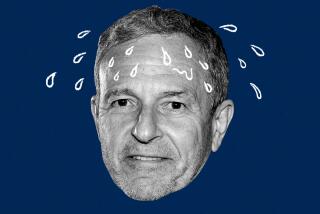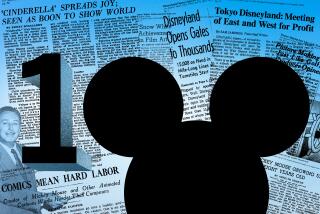Huge Debt Keeps Pressure on DIC to Keep Turning Out Animated TV Hits : Cartoon Firm Deals Way to Top
- Share via
Dennis the Menace, the all-American brat, is part Canadian.
Last year, DIC Enterprises in Burbank produced 13 half-hour cartoon episodes starring the mischievous 5-year-old that are now airing Saturday mornings on CBS.
Canada gives tax breaks to investors in television shows and movies if the programs are at least partly made there. So DIC got about $3 million in U.S. dollars from Canadians to finance the shows and qualified them for the write-offs by having an Ottawa animation company do drawing, voices and editing, according to Canadian executives and former DIC officials.
Exotic deals are nothing new to DIC (pronounced “deek”) and its president, Andy Heyward. A former writer for rival cartoon factories Hanna-Barbera and Filmation, Heyward, 39, has used his deal-making prowess to take DIC from a business he operated six years ago on his mother’s kitchen table to television’s biggest cartoon supplier with about 60 half-hours of children’s programming on the air a week. The privately held company has nearly $90 million in annual revenue.
Each Saturday morning, Heyward and DIC have six half-hours of shows on all three major networks, including CBS’ “Dennis the Menace,” NBC’s “ALF,” and ABC’s “The Real Ghostbusters.” On local stations, more than 50 half-hours of DIC shows air each week, including “Beverly Hills Teens” and “The Adventures of Teddy Ruxpin.”
Yet for all of DIC’s growth, competitors and business associates predict that DIC will be under increasing pressure to churn out hits, while the television market is softening, because DIC must service its debt growing out of a two-step, $70-million buyout Heyward led in late 1986 and 1987.
Last fall, with Prudential Insurance and the Bear, Stearns investment company as partners, Heyward finished buying out DIC’s previous owners, French businessman Jean Chalopin and Radio-Television Luxembourg. That left Heyward with about 52% of the company and a debt that probably costs the company from $5 million to $8 million a year to service, executives familiar with DIC say.
“Andy has no choice but to succeed,” Chalopin said. “He has a heavy burden on his back.”
If Heyward is worried, he doesn’t show it. “We are a growing company in an industry that is in a down cycle right now,” he said.
DIC maintains that it is profitable, but doesn’t release figures. People familiar with the firm estimate pretax profit before debt payments at $12 million to $15 million.
Some suggest that if the hits don’t keep coming, Heyward may have to sell a chunk of the company. Indeed, Heyward and his partners nearly sold one-third of DIC when they unsuccessfully tried to take it public by merging with Computer Memories, a publicly held shell company in Chatsworth that has $25 million in cash. The deal was scuttled last month when a dissident Computer Memories shareholder opposed it.
Michael Garstin, a managing director with Bear, Stearns, dismisses any idea that DIC must go public soon, or that it may need a cash infusion. “We recognize that there is some softness in the animation business, but we don’t see that at DIC,” he said.
Still, television industry executives note that all animation companies, including DIC, face problems on several fronts.
Children are watching tapes on videocassette recorders more. And new television ratings based on hand-held “people meters” reveal that fewer children watch TV programs than was previously thought, which could hurt advertising revenue. Toy makers that buy ad time on children’s shows also are suffering from an industry slump.
But the more serious problem is the glut of children’s shows, splintering ratings and advertising revenue. In some cities, 25 or more separate cartoon shows air on local stations, most of them daily. Add to that the 20 or so kid shows that the networks air Saturday mornings and children’s programs on cable channels like the Disney Channel and Nickelodeon.
“There is a tremendous shakeout going on. The market melted down because of an oversupply of cartoons,” said Melvyn Smith, vice president of programming for Tribune Broadcasting in Chicago.
Characteristically, Heyward sees the current shakeout as an opportunity for DIC to emerge as an even stronger player. “Things are moving rapidly. There is a changing of the guard,” he said.
Another problem is the sharp rise in production costs. Industry executives say a half-hour cartoon can cost from $150,000 to nearly $400,000 an episode. Although DIC, the industry’s only major non-union company, and most others subcontract much of the animation work to the Far East, where production is cheaper, Japanese animation executives say work there costs as much as 40% more than it was two years ago because of the stronger yen.
So Heyward and other animators are moving more work to Korea and Taiwan, a trend that worries some executives because it may mean problems meeting deadlines, as well as inconsistency in the quality in the drawings.
“DIC has had a big problem with quality control and consistency because they have been so spread out all over the Far East. They bend over backwards to fix it, but usually the problem is time,” said Phyllis Tucker Vinson, NBC’s vice president of children’s and family programs.
Heyward grew up in the television business. His father, Louis M. (Deke) Heyward, is a former Hanna-Barbera executive. In the early 1980s, Andy Heyward met Chalopin, who had founded DIC (“Diffusion Information Communication” in French) in the early 1970s. The two set up the company’s modest American operation in Los Angeles in 1982, where they first worked on Heyward’s mother’s kitchen table.
They immediately sold “Inspector Gadget” to local stations and “The Littles” to ABC, making their operation profitable by contracting the work out to animators in the Far East.
Heyward would rather talk about his cartoons than his deals and how they will be affected by industry problems. Heyward, who calls his methods “trade secrets,” frequently swears people he does business with to secrecy, associates say.
His family and friends say he is obsessed by work and success to the point that he often calls associates at midnight to talk about work. “He’s the kind who wants the name on top of the building. Prestige is very important to him and success is very important to him,” Chalopin said.
One reason for Heyward’s success has been his skill in convincing toy makers to participate in new shows either by committing to buy national advertising spots in advance, especially when they plan to develop products based on the show’s characters, or directly funding a show. This method, however, has become more difficult recently because of the toy industry’s financial woes.
Heyward also takes risks to get a show on the air. He now is selling a show to local stations called “Camp Malibu,” about California beach kids, that requires stations to commit to taking the show for only one year. Usually, producers require a two-year commitment to lock in a profit.
To cut its risk, DIC is producing only 40 shows instead of the usual 65 in syndication, with a promise to make more shows if it does well. But animators and distributors note that DIC is taking a risk because fewer shows produced mean more reruns, which could hurt ratings.
Heyward has also been extremely flexible when it comes to production services. For example, DIC co-produced a live-action show called “Zoobilee Zoo,” starring entertainer Ben Vereen. DIC’s role, however, was basically putting the deal together, for 25% of any profits. Hallmark financed the program while Binder Entertainment of Los Angeles produced it.
“Andy Heyward brought me in as co-executive producer. He made the deal and that’s the last I saw of him or DIC,” producer Steve Binder said.
DIC also sometimes does work for hire, as it did with the hit cartoon shows “The Real Ghostbusters” and “ALF.” Heyward argues that there is money to be made by simply producing. But industry executives note that even if such shows are hits, DIC loses out on future profits because it doesn’t own the characters.
Three months ago, Heyward moved to Burbank, where, from his sixth-floor office, he can look a mile to the east and see the studios of Walt Disney Co., founded by and named for American’s greatest animator.
Heyward often talks of Disney-like projects in the future, such as a DIC theme park, DIC boutiques and DIC prime-time family shows. And, he yearns for DIC to have the same kind of name recognition with its cartoon stars as Disney has with Mickey Mouse and Donald Duck.
“Walt Disney has been his idol, and he subconsciously has emulated him,” said Heyward’s father, Deke. “I think it’s the direction he wants to go toward, whether he wants to admit it or not.”
Heyward scoffs at suggestions that his goals are Disney-like, calling such talk pretentious. Still, Heyward’s plans are ambitious. And, industry executives say, it will take deft maneuvering by Heyward the next two years to bring those plans to reality.
More to Read
The biggest entertainment stories
Get our big stories about Hollywood, film, television, music, arts, culture and more right in your inbox as soon as they publish.
You may occasionally receive promotional content from the Los Angeles Times.










